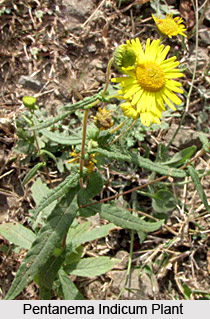 Pentanema Indicum is considered to be a medicinal plant in India. This Indian medicinal plant is common to most of the areas of the country. The Pentanema Indicum belongs to the "Asteraceae" which is Sunflower family. Pentanema Indicum is a tree of the deciduous forest zones which is found throughout India. This Indian medicinal plant grows to an altitude of 1800 meter in the Himalayas. They develop commonly on roadsides and in abandoned fields, particularly on drier sites.
Pentanema Indicum is considered to be a medicinal plant in India. This Indian medicinal plant is common to most of the areas of the country. The Pentanema Indicum belongs to the "Asteraceae" which is Sunflower family. Pentanema Indicum is a tree of the deciduous forest zones which is found throughout India. This Indian medicinal plant grows to an altitude of 1800 meter in the Himalayas. They develop commonly on roadsides and in abandoned fields, particularly on drier sites.
Different Names of Pentanema Indicum
It is known by different native names like: "Sona Sali" in Gujarati, "Sonkadi" in Marathi, "Bichhloo" in Hindi, "Han-navarikasoppu" and "Mugutisoppu" in Kannada, "Jimikipoo", "Mookuti" and "Poondu" in Tamil.
Characteristic Features of Pentanema Indicum
Pentanema Indicum is an erect herb with reddish and sparsely puberulous stems. Stems are branched in the upper part. Branches are cylindrical and leafy. Each leaf is ovate-lanceolate in shape. These leaves are cordate, auriculate and sessile. Alternately arranged, oblong-lance, leaves are stalk less, 3-8 cm long and hairy. The leaves have rounded "ears" at the base. In this Indian medicinal plant, the flowers heads are yellow in colour; they are solitary, terminal or leaf-opposed. The flowers are available throughout the year. The Achenes come as angled.
Medicinal Values of Pentanema Indicum
The Indian medicinal plant, Pentanema Indicum has extensive use by medical practitioners all over the country. The fresh roots from the herb are chewed to relieve abdominal pain. Thus, this plant is an essential source of remedy among the Bondo tribal inhabitants of southern Orissa. Kondhs of south-western Orissa uses the decoction of the roots for relief of fevers in children. Moreover, the roots of the Pentanema Indicum are used to relieve scorpion stings. The inflorescence is used for treating throat disorders. This whole Indian medicinal plant reportedly shows anti-fertility activity. Among the tribal inhabitants of southern and eastern Bihar, Pentanema Indicum is used in the form of a decoction by women as an oral contraceptive. A paste of the Pentanema Indicum is used to treat bone fractures among the Paharia in southern Bihar. Thus, the Pentanema Indicum plant is widely used as a medicinal plant but in a different method in several regions of India.



















